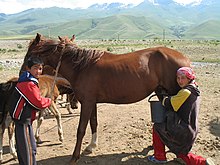Mare's milk
Mare's milk is the milk of female horses . It serves the foals as natural food in the first months of life, but is also occasionally used as a food supplement for humans.
Mare milk has due to the antibacterial and anti-inflammatory components, as well as texture of the udder of the milking frequency significantly less bacteria than cow milk of mares. It also contains fewer allergenic substances. It is more similar to human milk than cow's milk.
It contains about 1% fat, 6% milk sugar (lactose), 2% protein (55% of which is casein), 0.3% bulk and trace elements as well as vitamins and enzymes. Their dietary effect is based on specific ingredients such as immunoglobulins (approx. 10% of whey protein, including sIgA, sIgM), lactoferrin and lysozyme (antibacterial, antiviral), amylase, catalase, lipase, peroxidase, phosphatase, malate and lactate dehydrogenase, Lacto-transferrin, acetylcholine, beta-lactose (approx.5.5%, serves the intestinal flora, especially bifidobacteria as a nutrient substrate), linolenic acid (omega-3 fatty acid, 15 to> 25% in milk fat), vitamin C (approx mg / 100 ml, has an antioxidant effect), taurine (approx. 2.5 mg / 100 ml).
Mare's milk is used in medicinal treatments and to make kumys . Mare's milk is also used as an ingredient in cosmetics .
Mare's milk naturally has a high lactose content and is therefore not suitable for people with lactose intolerance or galactosemia . In kumys, the lactose content is lower, depending on the degree of fermentation, as the lactose is fermented into ethanol and carbon dioxide . In people with galactose intolerance, residues of galactose in the kumys can lead to complications.
Individual evidence
- ↑ http://www.haflinger-in-meura.de/stutenmilch
- ↑ Ingredients of mare's milk compared to milk from other animal species and breast milk
Web links
- Mare's milk - dietary properties Last update June 17th, 2009 (PDF, 87 kB)

